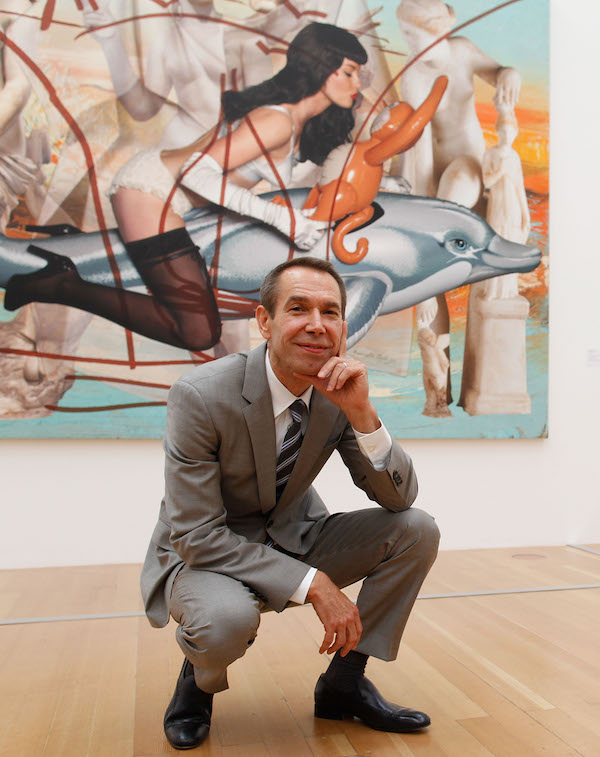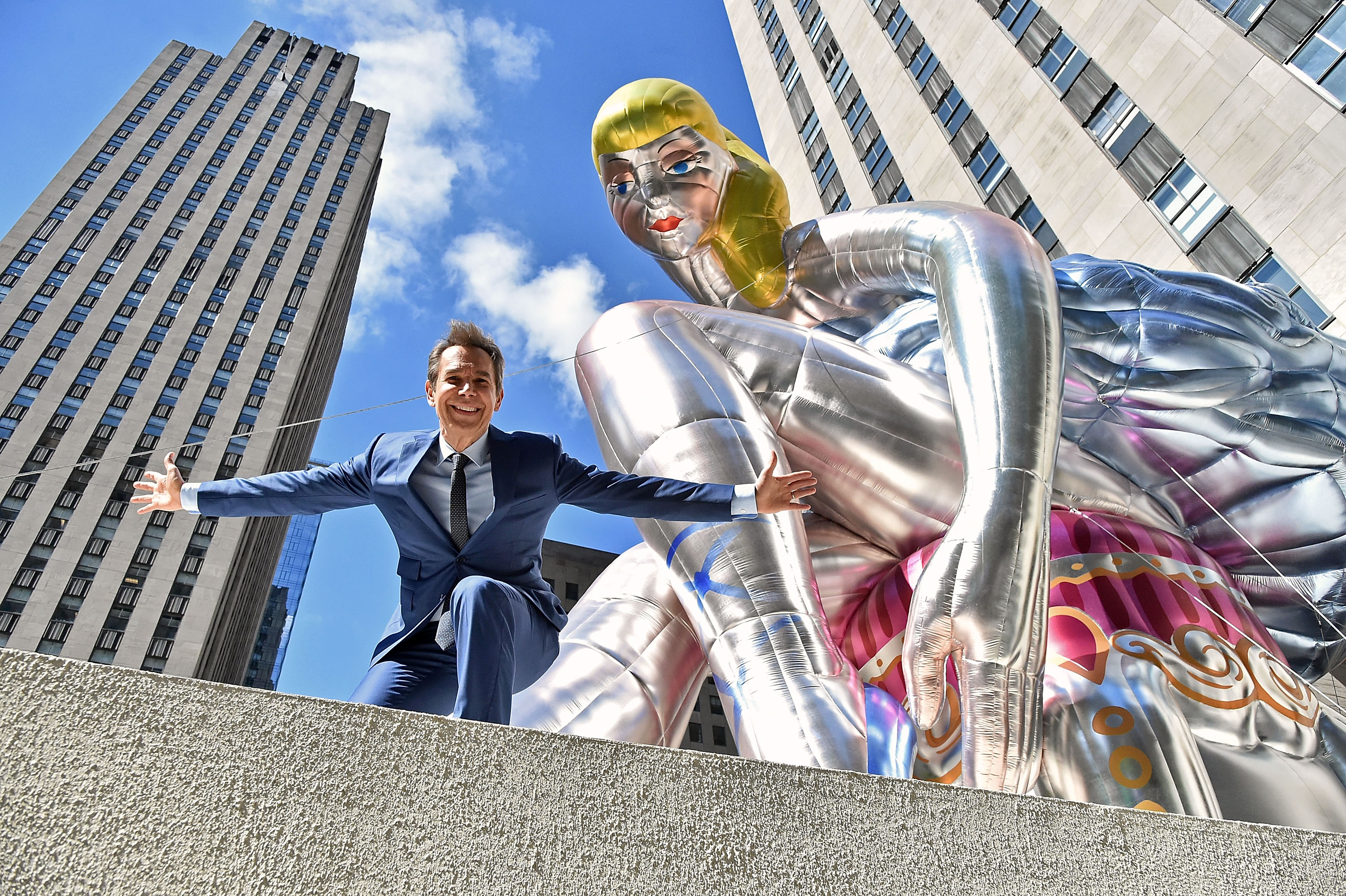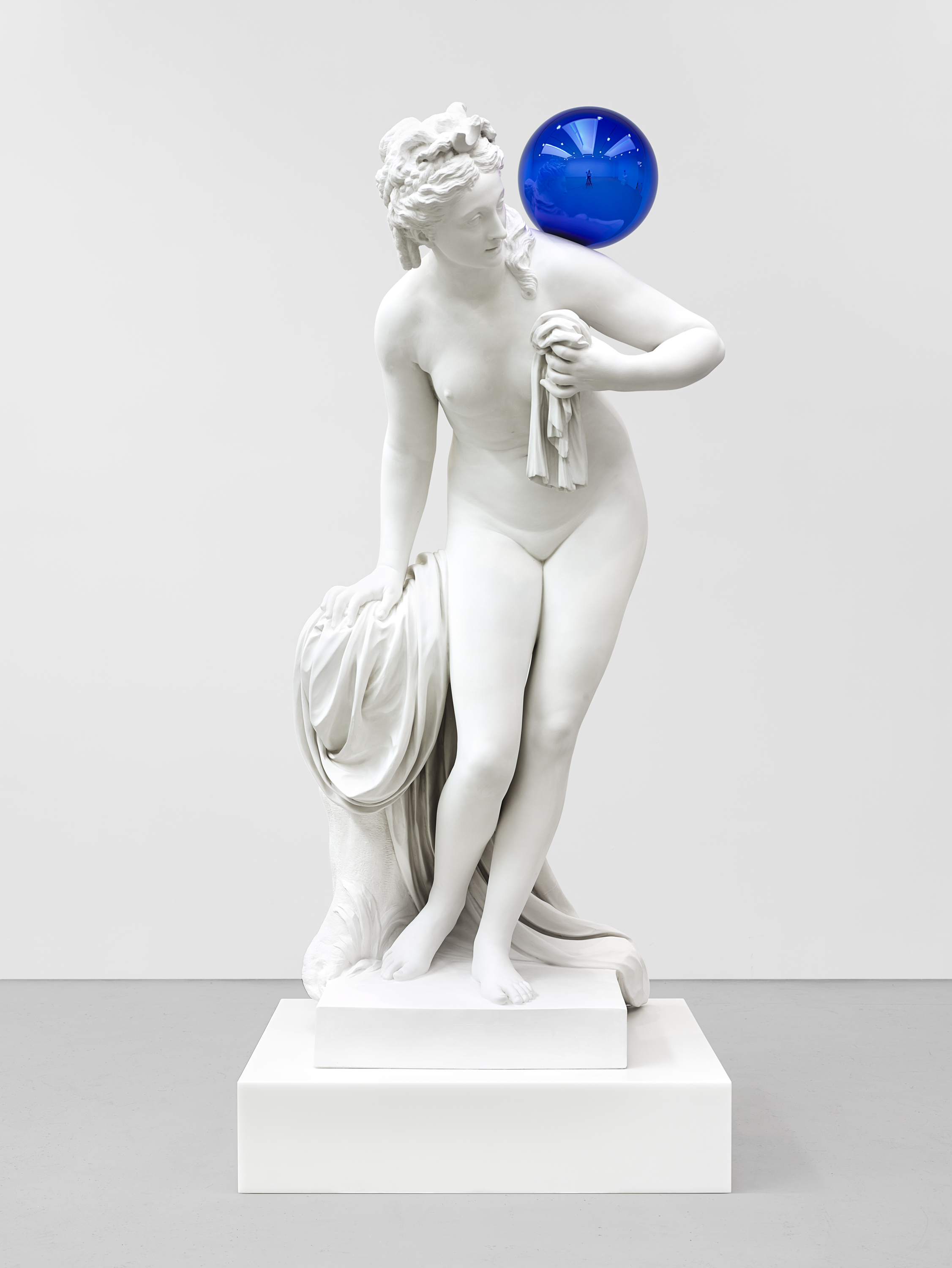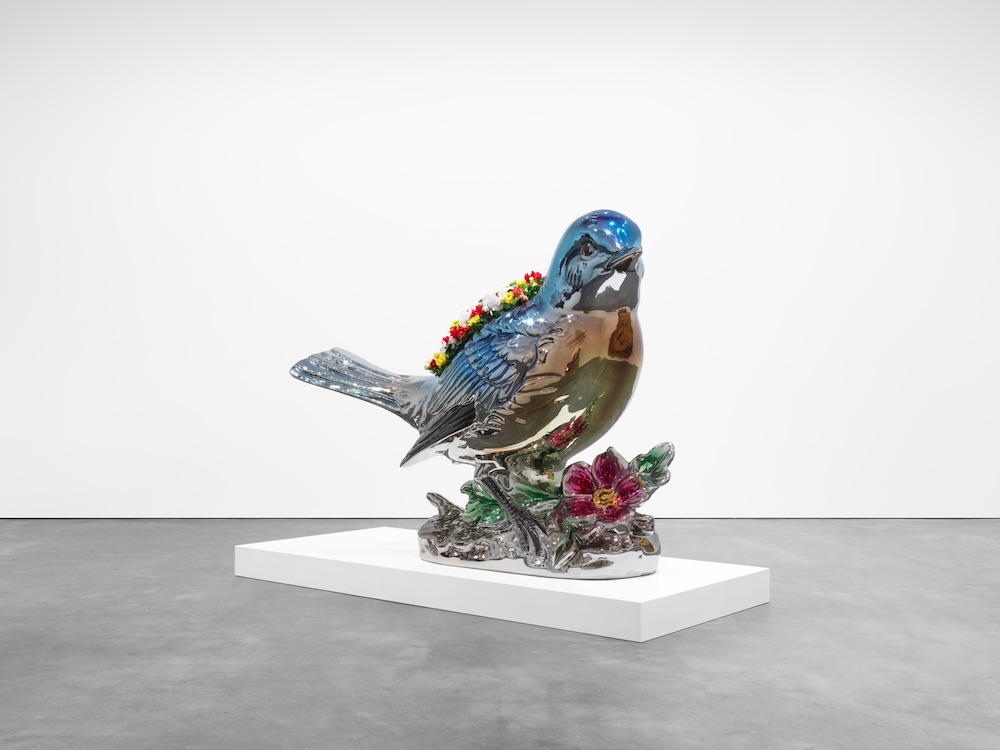Jeff Koons talks Art Basel Hong Kong and China vs the West
Mar 01, 2018

Few reputations precede an artist quite the way they do Jeff Koons, who comes to Hong Kong later this month as part of the city’s sixth iteration of Art Basel. He scatters his patter with grandiloquent terms like “transcendence”, “biological processes”, “acceptance” and the oddly expansive “everything’s in play”. There’s none of Damien Hirst’s effing and blinding; Koons is all about real-time epiphanies. He presents his own work at galleries in a way that has set the bar for others, and he regularly takes tour groups, dealers and collectors around his studio in Chelsea, New York. Four years ago, he launched his Hulk Elvis show at Gagosian Hong Kong with a 25-minute introduction sans notes, comparing his 12 Incredible Hulk figures, each made from copper and wood and weighing more than one tonne, to the heroes and heroines of Greek and Roman mythology.
And he does it all wearing Prada suits and pristine desert boots. Koons doesn’t look, dress or sound much like the prototypical artist – more like a self-help guru or a life coach. Or maybe an actor. Koons is a thespian playing versions of himself, a script waiting for a director to be attached and made into a blockbuster. Detractors in the press have called him everything from the “Donald Trump of art” and a “blow-dried Baptist selling swamp acres in Florida” to “dog excrement”. Koons also happens to be the world’s most expensive living artist; his Balloon Dog (Orange) sold for US$58.4 million at a Christie’s New York auction in 2013, besting German photographer and painter Gerhard Richter, whose 1968 painting Domplatz, Mailand, sold for US$37.1 million earlier the same year.
Despite a gracious invitation to visit Koons’ studio in New York, logistics means our interview was conducted via telephone. When his gentle voice emerges and greets me by name, it’s more balming than declarative – even oddly timid. Geography seems a good place to start. How do China’s reactions to his work, where Koons has many collectors, differ from those in the West?

Momentarily he’s surprised and distracted by studio happenings, and then refocuses. “That’s a really big question,” he chirps, then eases into play mode. “First of all, there are shared interests, shared visual stimulation and that’s because China, over the centuries, has influenced so much the perspective of the West. I could look at Renaissance painting or Mannerism – you could look at different periods of time and you can see the Eastern influence. So it’s really about archetypal imagery, a universal response and vocabulary to biology, and ideas of the eternal. Both through biology and ideas, these are the two realms of the eternal, and it’s very shared between Eastern and Western.” Yes, Koons’ predilection for biological reference surfaces a mere 92 seconds into the chat.
Andy Warhol conjured silkscreens of Chairman Mao; Roy Lichtenstein appropriated Chinese gardens as content for his Ben Day dot paintings in the 1990s; could Koons ever appropriate Xi Jinping and the Chinese dream as some glossy, inflated object? “I have,” he says, startlingly. Again, his response is not quite all it seems. “If I look at different series of works, the Hulk Elvis series, I was making a very direct reference to Eastern culture. You know, you could have Hulk as a superhero, or from an Eastern perspective, a guardian god, but one who could tear the house down at any moment. My Hulk (Organ) also incorporates sound, and the reason for that is, when a guardian god presents himself there’s a tremendous noise. So already in several works, Hulk (Bell), Hulk (Carriage), Hulk (Wheelbarrow)… many incorporate a directly Chinese influence and imagery.”
Koons’ triumph happened mostly in the 1990s, with a second coming in the past decade. He plunged into American subculture, popular art and kitsch with a simple goal: to make works that resemble consumer objects and give them cue-card labels like “Banality” and “Celebration”. And it worked, like the soup cans and washing-powder boxes of Warhol’s supermarket universe. Koons kindled a Willy Wonka-esque fantasy and practicality, in a veritable playroom of product: giant-sized toys, baseballs, stacked farm animals, rabbits, Pink Panthers, teddy bears and sirens, in stainless steel or porcelain.

And they sold like proverbial hotcakes. Who could forget the impossibly gauche 1988 white and gold rendering of Michael Jackson and Bubbles, which sold at Sotheby’s New York in 2001 for US$5.4 million? Koons has reproduced on a grand scale all the American cultural icons that are hidden in children’s bedrooms and souvenir shops, and elevated them to the status of art. He’s the ultra-deluxe Duchamp, Warhol at the gilt-edged frontlines of the high-key lifestyle.
Love him or hate him – and like his art, it’s always polarising – Koons creates post-pop, neo-pop, art-porn seduction. He foresaw the demand, obsession and fetishisation attached to items of so-called luxury and exploited the rare rarefied retail trope. British artist Grayson Perry says Koons’ art is tantamount to luxury products that have become indistinguishable from a Ferrari. (And it’s no wonder that Koons has collaborated with LVMH, BMW and H&M, among others in the retail world.)
As such, Koons speaks words like “craftsmanship” and “foundry”, and talks about “quality” to a level redolent of the French and Italian CEOs of every major luxury purveyor. Along the way, he’s attracted the same level of cultural influencers – he’s done the artwork for Lady Gaga’s album Artpop, he’s collected by Pharrell Williams and he’s name-checked by Jay-Z in “Picasso Baby”.
But how does the York, Pennsylvania-born former financial trader feel if someone compares him to a 21st-century art version of Hermès, LVMH or Chanel? Is he complimented or insulted by the luxury product sentiment? Koons, forever dodging journalistic bullets, finds an inimitably evasive but revealing window of opportunity. “I remember in 1986, I worked on a piece called Bob Hope.” He explains that the sculpture had a piece of felt that was cast in stainless steel at its base, but which was missing when he went to the foundry. “I said, ‘Why don’t you have it? Where has it gone?’ And they said ‘No one’s ever going to see it.’” Except Koons, of course.

“You know, why I go to such level of detail,” he says. “I want to preserve the integrity of the object and capture every detail, both every part of perfection and imperfection of the object, because what I was really trying to do was communicate to the viewer that I cared about them. I wanted to show them I was giving them so much attention.” Sensing a certain suspicion or incredulity on my part, he retreats to his armoury and varnishes an anecdote to substantiate the thought, albeit one that’s product-driven. “Take Steve Jobs; if you look at the design of the iPhone, or the back of it – there is a story that Walter Isaacson tells in his Steve Jobs book, about Steve Jobs’ father teaching him when they’re painting a fence, you have to paint the other side too, even if you don’t see it. He captures in the Jobs biography this moment. Again, it’s about detail. You never know when somebody could be looking on the other side of that fence. And you don’t want them to be disappointed.”
Perhaps aware of sounding suddenly too lofty, a humbler Koons adds a caveat, almost like spin-therapy, dabbing at the just-spoken and still-drying words with a brush of water to soften the glare. “Can I just say, I don’t want to compare myself to Steve Jobs. But, I do want to share this idea of communicating trust to the viewer. And it’s about these activities being about humanism.
At the end of the day, it’s about self-acceptance and the ability to accept others, and the only thing that matters is the relationship with the self and other people. And to communicate trust, then honour and respect are of real value, and to me, at the core of what art is.” At least his art.
Some of which will be viewable through David Zwirner’s gallery this month at Art Basel in Hong Kong. How were decisions made about what pieces to bring? Was there a curatorial power struggle, a clashing of cultural hulks between the world’s most expensive living artist and one of the world’s most successful art dealers? Not a bit. “First of all, it’s David’s booth. It’s David’s gallery,” says Koons. “He was kind enough to invite me to have a focal point at the fair of my work. He presented me the opportunity of how much space I would like. I chose to incorporate half the space. I went through and edited my work, and chose what I thought worked well together and were unified by a central theme, and communicated with each other. I think all of the works, have these universal aspects, these qualities that we celebrate in our aesthetics, both Eastern and Western.”

And then, pop, pop, bam, Koons hits nirvana: “At the core of my work, Stephen, the dialogue is about transcendence and how we can achieve transcendence. Or, how can we reach a higher level of transcendence, a level of total consciousness? These interests are at the base of Eastern philosophy. All the works participate in the affirmation of the self and they also stimulate the viewer, so that the viewer is aware that art is the essence of their own potential. At the end of the day, it’s all metaphor for self-acceptance, and that you accept other people.”
He goes on to say how accepting himself has allowed the possibility of going “outside himself” and thereby accepting others. “Everything is a metaphor for that,” he says. “You do that by removing judgement, segregation, discrimination – all of these activities disempower the self. As soon as you alienate or segregate or make judgement, you’ve already eliminated certain energies to not be at your disposal, to not be able to incorporate into your vocabulary, and that creates anxiety. And anxiety and fear are what keep us from reaching a higher consciousness.” High-falutin’ it may sound, but it’s a brilliantly clever strategy, or performance; to pooh-pooh his art work as popular trash gussied up as luxuriant art only exaggerates deficiencies or inadequacies on the part of the viewer, not in the art or artist’s success or failure. Those are the rules à la Koons.
It’s a strategy reminiscent of Chinese philosopher Sun Tzu’s Art of War: “The battle is won before it’s even fought” – a line invoked by cinema’s most prolific financier, Gordon Gekko, in Oliver Stone’s Wall Street. Did Koons, also a former trader, find the film inspirational during the 1980s? “I was a commodities broker,” he says. “Being a broker for me was really being a salesman, following the markets, and also my desire to bring new clients into the firm. It was something I did that I was able to make enough money to make my works, but something I could not continue to do.”
Art intervened. “I was thinking about my artwork all the time, when at a certain point I was working on my equilibrium tanks [basketballs suspended in solution] around 1984 or 1985, and I was always on the phone with Dr Richard P Feynman, the Nobel Prize winner, trying to figure out how to create permanent equilibrium [he laughs] instead of really following the market. I think you reach a certain point, and you have no other options, you just have to do what you have to do, and mine was to make my work, and follow my interest and accept the consequences of that.”
Has success made it harder or easier to produce art as he’s matured? “Each moment in your life has its own energies, its own relevance and profoundness. What youth has on its side is an immediacy. As time goes on, you have more memories, associations and knowledge, so the work automatically develops a greater profoundness because you have more time to reflect on what gestures you want to make. And you develop a greater responsibility to the community. When you’re young, it’s really about self-ascendance, wanting more and more, with wider parameters. But once you achieve that and learn how to expand your parameters, you automatically want to take care of those around you and share with them. And so you want to share the idea and ability for transcendence with those around you. And I think that’s inherent in human essence.”
Koons, not unlike his British peer Damien Hirst, employs more than 100 people. Does he still produce the pieces himself? “You know, I have a studio, so there’s a tremendous misunderstanding about how I work. I don’t have a factory. I produce very few works per year. In a really good year, I may be able to make maybe 10 to 15 sculptures, and on average I’d do about 10 paintings per year. There is very low production – it is not a factory.”
Given the prices his work can fetch, how much does he, like a luxury brand, control the production of a successful work like Balloon Dog? “The power of art is not about the economics. The economics is a secondary abstract thing that happens. The power of art is to come into contact with the potential that we have as human beings, the information and resources that we have, and how we can empower ourselves to become vaster. And every time that we make a work, or that work is being viewed or interpreted by a viewer, it’s creating a situation where the essence of our potential is taking place. That’s what art is about. That’s what has value. If you can duplicate that over and over again, that does happen. But it doesn’t happen through distribution; it happens from inside.”
There you have it, folks. Go play, perform, succumb, empower and transcend with some gilt-edged glossy art-travagance, courtesy of Mr Koons. And then Instagram the heck out of it. Woof, woof.
This feature originally appeared in the March 2018 print issue of #legend





























